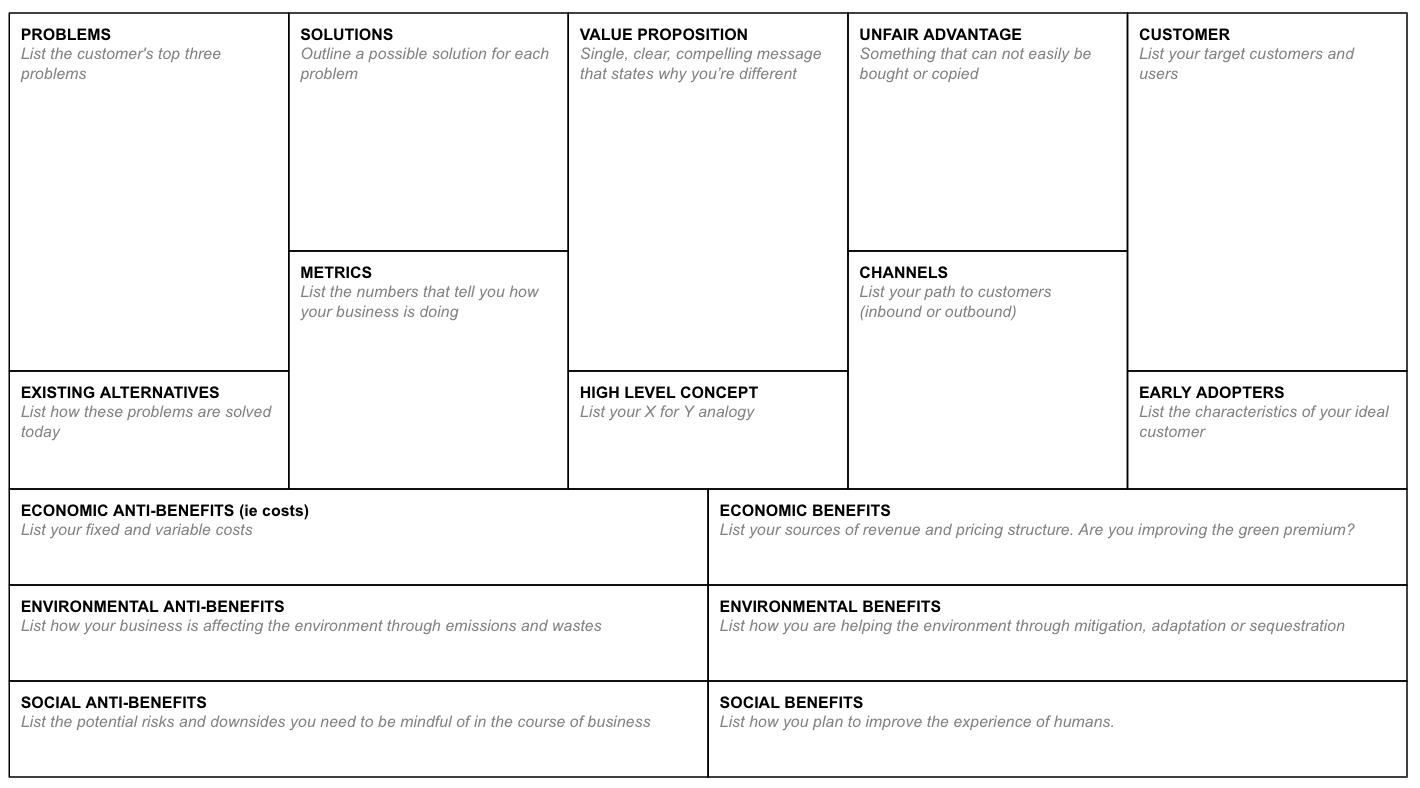I've been using the Lean Canvas as a business model template for many years. It's brilliant, it's broad yet concise and pretty easy to complete. However, it does have one issue. Like the Business Model Canvas before it, it was designed for ideas and businesses where revenue is the key measure of success.

Image credit - Leanstack
At More Traction, our mission is to help Climate Techs scale, so using a business model template that was solely focused on revenue was not good enough for many of the businesses we work with.
By definition, Climate Techs are trying to do something about climate change. In the process, some are also improving the lives of the people impacted by it. So it just didn't make sense to judge a climate tech solely based on revenue if they are doing so much more.
Furthermore, the new breed of real impact investors is equally concerned with the environmental and social benefits you'll deliver, as they are with the commercial viability and return on investment of the venture.
Introducing the Green Lean Canvas
A simple definition of sustainable suggests that it is when the Environmental, Social and Economic factors are in balance. Too much of any single one and a business cannot sustain itself into the future. (I was tempted to call it the "Sustainable Lean Canvas", but that was a mouthful and "Green Lean Canvas" sounds way better.)

Image credit - unknown
The bottom part of the current Lean Canvas covers the costs and revenue of the product. These are the Economic outcomes of the business model.
One of the great things about Economic outcomes like costs and revenue is how easy they are to measure. It's easy to understand where money is going and where it's coming from, and we have some well-established ways (ie accounting) of measuring and reporting on it.
However, measuring Environmental and Social outcomes is a completely different story. They aren't standardised, readily available or easily understood - they are hard to measure. But just because something is hard to measure doesn't mean we shouldn't capture it or track it.
That's why I created the Green Lean Canvas. I wanted to give Climate Techs a way to capture and report on the full suite of outcomes that their business model is producing - both the positive (ie the benefits) and the negative (ie the anti-benefits)!
I've taken inspiration from how Economic outcomes (ie money) are captured on the Lean Canvas (through costs and revenue) and applied that same logic to both Environmental and Social outcomes.
It's not perfect, but it's a start. I'll be the first to accept that it's getting too busy, but I just want to get this conversation started.
Here's what it looks like:

Here are the new additions:
1) Environmental - What you do to the planet
Benefits:
- Mitigation: how is your product reducing emissions intensity?
- Adaptation: how is your product helping those affected by climate change to adapt?
- Capture & Sequestration: how is your product capturing or sequestering emissions?
- Natural Capital: how is your product improving Natural Capital (air, water, biodiversity, carbon, etc)
Disbenefits:
- Scope 1 emissions: what are the emissions your business is directly responsible for?
- Scope 2 emissions: what is your share of emissions from your electricity provider?
- Scope 3 emissions: what is your share of emissions within your supply chain - upstream and downstream?
- Natural capital: how is your product reducing Natural Capital?
- Other wastes: what other waste is your business creating and not already captured in your Scope 1-3?
2) Social - What you do to people
Benefits:
Social outcomes that you are actively seeking or trying to address and which ultimately translate into improvements to the experience of humans. For example: improve happiness, improve equality, reduce poverty, reduce crime, improve health, reduce famine, etc.
Disbenefits:
Risks and potential downsides that your product might create - sometimes unbeknown to you.
For example: supporting child labour or perpetuating social inequality within your supply chain.
3) Economic - What you do to the economy
Benefits:
- What's your pricing and how will it translate into an increase in revenue?
- What are you doing to decrease the "green premium" payable for a sustainable alternative?
- How are you helping achieve compliance with climate change regulations?
Disbenefits:
- Upfront Costs
- Ongoing Costs
Downloads
PDF
https://20466474.fs1.hubspotusercontent-na1.net/hubfs/20466474/Green%20Lean%20Canvas%20V0.1%20(1).pdf
Google Slides
https://docs.google.com/presentation/d/1T8TsWOzUry-UnWMW4ifyMxfM5uRwA4-jnOa9aT05cUs/edit#slide=id.p